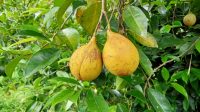- STARFRUIT does not have something to do with night time though it has root ‘star.’ This star-shaped fruit is appropriate for quenching thirst. Optionally, it can be made into fruit salad.
Starfruit, also known as carambola, is a tropical fruit native to Southeast Asia but is now cultivated in many tropical and subtropical regions around the world. It gets its name from its distinctive shape, resembling a star when sliced crosswise, hence the name “starfruit.” The scientific name for starfruit is Averrhoa carambola.
Here are some key features and facts about starfruit:
Appearance: Starfruit is a yellow-green fruit with a waxy skin. When cut crosswise, the fruit slices have a star-like shape, with ridges extending from the center to the five corners.
Flavor: Starfruit has a unique taste that can be described as a combination of citrusy and mildly sweet flavors. The flavor can vary depending on the variety and ripeness of the fruit.
Nutritional Profile: Starfruit is low in calories and contains a good amount of fiber, vitamin C, and antioxidants. It also provides small amounts of other vitamins and minerals, including vitamin A, potassium, and magnesium.
Texture: The flesh of starfruit is crisp and juicy, similar to that of a grape or an apple. The skin is thin and edible but may have a slightly sour taste.
Varieties: There are several varieties of starfruit, with the most common ones being the sweet type and the sour type. The sweet varieties are generally consumed fresh, while the sour types are often used in cooking and making preserves.
Health Considerations: While starfruit is generally safe and nutritious for most people, it contains natural compounds called oxalates. These compounds can be harmful to individuals with kidney problems, as they may cause kidney damage or affect kidney function. If you have kidney issues, it is advisable to consult a healthcare professional before consuming starfruit.
Selecting and Storing: When choosing starfruit, look for fruits that are firm, shiny, and evenly colored. Avoid ones with blemishes, bruising, or wrinkled skin. Ripe starfruit should have a slight yellow color. Unripe fruit may be stored at room temperature until it ripens, and ripe fruit can be refrigerated for a few days.
Culinary Uses: Starfruit can be enjoyed in various ways. It is often eaten fresh as a snack or added to fruit salads for its unique appearance and flavor with spices made from salt, chili and palm sugar. The slices can be used as a garnish for drinks or used in smoothies. In some cuisines, starfruit is cooked in savory dishes such as stir-fries and curries.
Meanwhile, Balinese people often take advantage its young leaves for making lawar vegetables. Having picked all leaves, they are boiled half-done. They are optionally let be in intact form or chopped mixed with chopped chicken, pork, and others with Balinese seasoning. It is called lawar.
In summary, starfruit is a tropical fruit known for its distinct star-shaped appearance, refreshing flavor, and nutritional benefits. It can be enjoyed in a variety of ways and is a delightful addition to both sweet and savory dishes.











